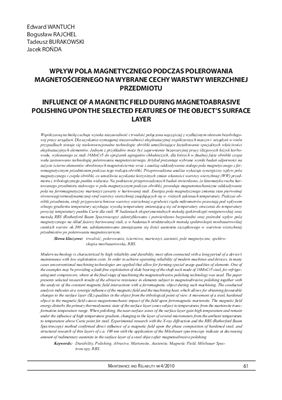Статья. Опубликована в журнале "Maintenance and reliability". –
2010. – Vol. 2010 – P. 61-71.
Авторы: Edward Wantuch, Bogusław Rajchel, Tadeusz Burakowski, Jacek
Rońda.
Статья на польском и английском языках.
Название на русском языке: Влияние магнитного поля во время
магнитно-абразивного полирования от выбранных особенностей
поверхностного слоя детали.
Аннотация к статье на английском языке:
Mode technology is characterized by high reliability and durability, most often connected with a long period of a device’s maintenance with low exploitation costs. In order to achieve operating reliability of mode machines and devices, in many cases unconventional machining technologies are applied that allow for forming special usage qualities of elements. One of
the examples may be providing a fault-free exploitation of slide bearing of the shaft neck made of 16MnCr5 steel, for refrigerating unit compressors, where at the final stage of machining the magnetoabrasive polishing technology was used. The paper presents selected research results of the abrasive resistance in elements subject to magnetoabrasive polishing together with
the analysis of the constant magnetic field interactions with a ferromagnetic object during such machining. The conducted analysis indicates at a synergic influence of the magnetic field and the machining heat, which allows for obtaining favourable changes to the surface layer (SL) qualities in the object from the tribological point of view. A movement of a steel, hardened
object in the magnetic field causes magnetomechanic impact of the fi eld upon ferromagnetic martensite. The magnetic field energy disturbs the primary thermodynamic state of the surface layer zones subject to temperatures from the martensite transformation temperature range. When polishing, the near-surface zones of the surface layer gain high temperature and remain
under the influence of high temperature gradient, changing in the layer of several micrometers from the ambient temperature to temperature above Curie point for steel. Experimental research with the X-ray diffraction and the RBS (Rutherford Beam Spectroscopy) method confirmed direct influence of a magnetic field upon the phase composition of hardened steel, and structural research of thin layers of c.a. 100 nm with the application of the Mössbauer spectroscopy indicate at decreasing amount of rudimentary austenite in the surface layer of a steel object after magnetoabrasive polishing.
Mode technology is characterized by high reliability and durability, most often connected with a long period of a device’s maintenance with low exploitation costs. In order to achieve operating reliability of mode machines and devices, in many cases unconventional machining technologies are applied that allow for forming special usage qualities of elements. One of
the examples may be providing a fault-free exploitation of slide bearing of the shaft neck made of 16MnCr5 steel, for refrigerating unit compressors, where at the final stage of machining the magnetoabrasive polishing technology was used. The paper presents selected research results of the abrasive resistance in elements subject to magnetoabrasive polishing together with
the analysis of the constant magnetic field interactions with a ferromagnetic object during such machining. The conducted analysis indicates at a synergic influence of the magnetic field and the machining heat, which allows for obtaining favourable changes to the surface layer (SL) qualities in the object from the tribological point of view. A movement of a steel, hardened
object in the magnetic field causes magnetomechanic impact of the fi eld upon ferromagnetic martensite. The magnetic field energy disturbs the primary thermodynamic state of the surface layer zones subject to temperatures from the martensite transformation temperature range. When polishing, the near-surface zones of the surface layer gain high temperature and remain
under the influence of high temperature gradient, changing in the layer of several micrometers from the ambient temperature to temperature above Curie point for steel. Experimental research with the X-ray diffraction and the RBS (Rutherford Beam Spectroscopy) method confirmed direct influence of a magnetic field upon the phase composition of hardened steel, and structural research of thin layers of c.a. 100 nm with the application of the Mössbauer spectroscopy indicate at decreasing amount of rudimentary austenite in the surface layer of a steel object after magnetoabrasive polishing.

